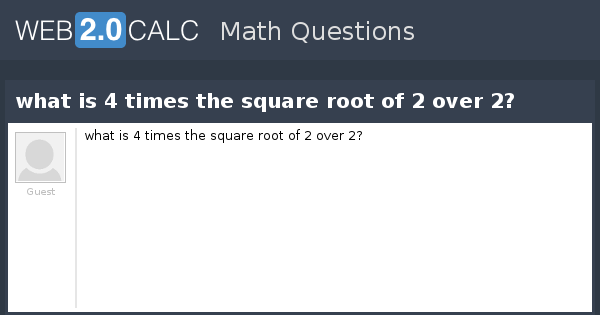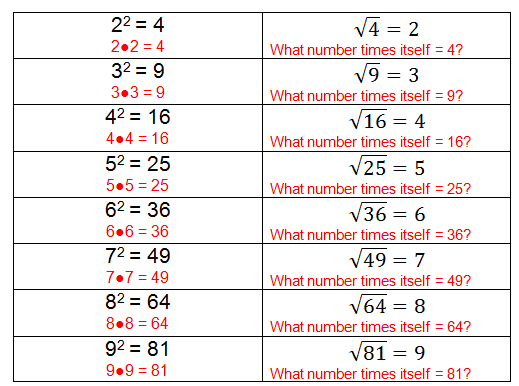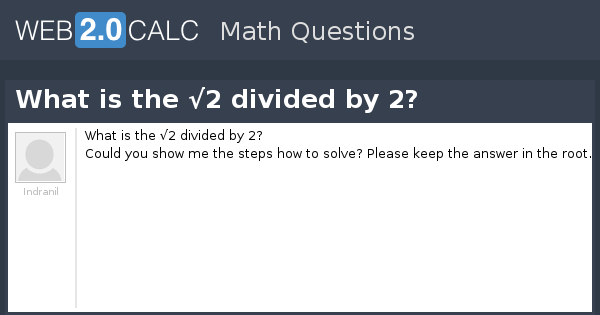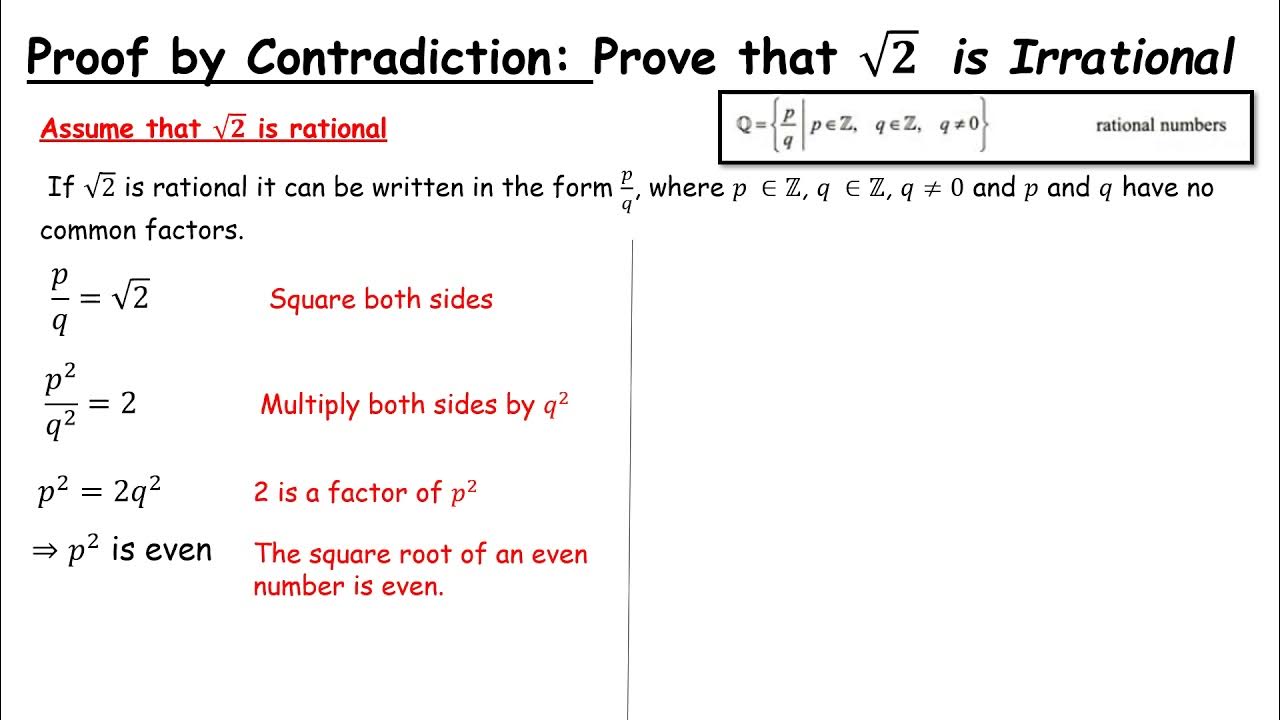Topic square root of 2 calculator: Discover the most accurate and user-friendly square root of 2 calculator. Whether you're a student, engineer, or math enthusiast, this tool provides precise calculations for \(\sqrt{2}\) to various decimal places. Learn about its significance, applications, and how to use it effectively for all your mathematical needs.
Table of Content
- Square Root of 2 Calculator
- Introduction to the Square Root of 2
- What is the Square Root of 2?
- Mathematical Significance of \(\sqrt{2}\)
- Historical Background
- Methods to Calculate \(\sqrt{2}\)
- Manual Calculation Techniques
- Using Online Calculators
- Mathematical Software for Precision
- Applications of \(\sqrt{2}\) in Different Fields
- Geometry and \(\sqrt{2}\)
- Algebraic Uses of \(\sqrt{2}\)
- Trigonometric Applications
- Engineering and Physics
- Approximations of \(\sqrt{2}\) to Various Decimal Places
- Square Root of 2 Table
- Frequently Asked Questions
- Conclusion
- YOUTUBE: Video hướng dẫn cách tính căn bậc hai trên máy tính khoa học một cách dễ hiểu và chính xác. Phù hợp cho những ai đang tìm kiếm cách tính căn bậc hai của số 2 bằng máy tính.
Square Root of 2 Calculator
The square root of 2, represented as \(\sqrt{2}\), is an important mathematical constant. It is the positive solution to the equation \(x^2 = 2\).
Value of \(\sqrt{2}\)
The numerical value of \(\sqrt{2}\) is approximately 1.4142135623730951. This value is irrational, meaning it cannot be exactly expressed as a fraction of two integers and its decimal representation goes on forever without repeating.
Calculating \(\sqrt{2}\)
To calculate \(\sqrt{2}\) to various decimal places, you can use online calculators or mathematical software. Here are some steps and methods you might use:
- Manual Calculation: Using methods like the Babylonian method (also known as Heron's method) which involves iteratively averaging values to get closer to the actual square root.
- Online Calculators: Many online calculators are available that can quickly provide the value of \(\sqrt{2}\) to many decimal places. Simply enter "square root of 2" in a search engine to find these tools.
- Mathematical Software: Programs like MATLAB, Mathematica, or even spreadsheet software like Excel can compute square roots to a high degree of precision.
Applications of \(\sqrt{2}\)
The square root of 2 appears in various mathematical contexts:
- Geometry: In a right-angled isosceles triangle, the length of the hypotenuse is \(\sqrt{2}\) times the length of each leg.
- Algebra: Solutions to quadratic equations where the discriminant is 2.
- Trigonometry: Ratios in trigonometric functions for certain angles.
- Engineering and Physics: Calculations involving waves, oscillations, and other phenomena.
Table of Approximations
Here is a table of the square root of 2 to various decimal places:
| Decimal Places | Value |
|---|---|
| 1 | 1.4 |
| 2 | 1.41 |
| 3 | 1.414 |
| 4 | 1.4142 |
| 5 | 1.41421 |
| 6 | 1.414214 |
| 7 | 1.4142136 |
| 8 | 1.41421356 |
| 9 | 1.414213562 |
| 10 | 1.4142135623 |
Using precise values of \(\sqrt{2}\) can be crucial in many fields of science and engineering. Always ensure to use the appropriate number of decimal places for your specific application.

READ MORE:
Introduction to the Square Root of 2
The square root of 2, denoted as \(\sqrt{2}\), is a fundamental mathematical constant. It is the positive solution to the equation \(x^2 = 2\) and is known to be an irrational number. This means it cannot be expressed exactly as a simple fraction and its decimal representation is non-terminating and non-repeating.
The value of \(\sqrt{2}\) is approximately 1.4142135623730951. It has been studied for centuries and has significant implications in various fields of mathematics, science, and engineering.
Here are some key aspects of \(\sqrt{2}\):
- Historical Background: The discovery of \(\sqrt{2}\) is often attributed to ancient Greek mathematicians. It is famously known from the diagonal of a square with side length 1.
- Mathematical Significance: \(\sqrt{2}\) plays a crucial role in geometry, particularly in the context of right-angled triangles and the Pythagorean theorem.
- Irrational Nature: \(\sqrt{2}\) cannot be precisely written as a fraction, and its decimal expansion goes on infinitely without repeating.
To calculate the square root of 2, various methods can be employed:
- Manual Calculation Techniques: Methods such as the Babylonian method (or Heron's method) involve iteratively averaging values to approach the square root.
- Online Calculators: Easily accessible tools on the internet provide quick and accurate calculations for \(\sqrt{2}\).
- Mathematical Software: Advanced software like MATLAB, Mathematica, and even Excel can compute \(\sqrt{2}\) to a high degree of precision.
Understanding and using \(\sqrt{2}\) is essential in many areas, including:
- Geometry: It is used to determine the length of the diagonal of a square and in various other geometric calculations.
- Trigonometry: \(\sqrt{2}\) appears in trigonometric functions and identities.
- Engineering and Physics: Calculations involving waveforms, oscillations, and other physical phenomena often require \(\sqrt{2}\).
The following table provides the value of \(\sqrt{2}\) to various decimal places for reference:
| Decimal Places | Value |
|---|---|
| 1 | 1.4 |
| 2 | 1.41 |
| 3 | 1.414 |
| 4 | 1.4142 |
| 5 | 1.41421 |
| 6 | 1.414214 |
| 7 | 1.4142136 |
| 8 | 1.41421356 |
| 9 | 1.414213562 |
| 10 | 1.4142135623 |
With the availability of various tools and methods, calculating and understanding the square root of 2 is accessible and valuable for diverse applications.
What is the Square Root of 2?
The square root of 2, denoted as \( \sqrt{2} \), is a number that, when multiplied by itself, equals 2. In mathematical terms, \( \sqrt{2} \times \sqrt{2} = 2 \). It is an irrational number, meaning it cannot be expressed exactly as a simple fraction and its decimal representation goes on forever without repeating.
Here are some key points about \( \sqrt{2} \):
- The approximate value of \( \sqrt{2} \) is 1.414213562373095...
- It is often used in geometry, especially in relation to right-angled triangles. For example, in a right-angled triangle with both legs of length 1, the hypotenuse will be \( \sqrt{2} \).
- It has historical significance as one of the first numbers proven to be irrational by the ancient Greeks.
The calculation of \( \sqrt{2} \) can be approached in various ways, including:
- Manual Calculation: Using methods like the Babylonian method (also known as Heron's method) which is an iterative numerical technique.
- Online Calculators: Many online tools allow you to easily calculate the square root of 2 to a high degree of precision.
- Mathematical Software: Software such as MATLAB, WolframAlpha, and others can compute \( \sqrt{2} \) with great accuracy.
To better understand the value of \( \sqrt{2} \), here is a table of its approximations to various decimal places:
| Decimal Places | Approximation of \( \sqrt{2} \) |
|---|---|
| 1 | 1.4 |
| 2 | 1.41 |
| 3 | 1.414 |
| 4 | 1.4142 |
| 5 | 1.41421 |
Understanding \( \sqrt{2} \) is fundamental in various branches of mathematics and its applications are widespread, from geometry and algebra to physics and engineering.
Mathematical Significance of \(\sqrt{2}\)
The square root of 2, often denoted as \(\sqrt{2}\), holds profound mathematical significance. It is the first known irrational number, meaning it cannot be expressed as a simple fraction. Its decimal representation is non-repeating and infinite: 1.414213562373095... This discovery, attributed to the ancient Greeks, notably shook the foundations of mathematics by revealing the existence of numbers that couldn't be neatly categorized within the rational number system.
The importance of \(\sqrt{2}\) extends beyond its irrationality. Here are some key aspects of its mathematical significance:
- Geometry: In geometry, \(\sqrt{2}\) is the length of the diagonal of a square with side length 1. This relationship is derived from the Pythagorean theorem: for a right-angled triangle with legs of length 1, the hypotenuse (diagonal) is \(\sqrt{2}\).
- Algebra: \(\sqrt{2}\) appears in various algebraic contexts, particularly in equations involving quadratic irrationals. It serves as a simple yet fundamental example of a solution to the equation \(x^2 = 2\).
- Number Theory: The irrationality of \(\sqrt{2}\) can be proven using various methods, such as proof by contradiction, which assumes that \(\sqrt{2}\) can be written as a fraction \( \frac{a}{b} \) in its lowest terms, leading to a contradiction.
The computation of \(\sqrt{2}\) has fascinated mathematicians for centuries. Ancient approximations include the Babylonian method, which provided impressively accurate values long before the advent of modern computational tools. Today, \(\sqrt{2}\) has been calculated to trillions of decimal places using advanced algorithms and software, illustrating the progress in numerical methods and computational power.
Overall, the square root of 2 is not just a mathematical curiosity; it is a cornerstone of mathematical theory and practice, influencing fields as diverse as geometry, algebra, and number theory.
Historical Background
The history of the square root of 2, denoted as \(\sqrt{2}\), is rich and spans across several ancient civilizations, each contributing significantly to the mathematical understanding of this irrational number.
Babylonian Approximation: One of the earliest known approximations of \(\sqrt{2}\) dates back to the Babylonians around 1800-1600 BCE. A clay tablet known as YBC 7289 demonstrates a remarkably accurate approximation of \(\sqrt{2}\) as 1.414213, which is precise to six decimal places. This showcases the advanced mathematical skills of the Babylonian mathematicians who used sexagesimal (base-60) numerals for their calculations.
Greek Contributions: In ancient Greece, the discovery of the irrational nature of \(\sqrt{2}\) is attributed to the Pythagoreans. The legend tells that Hippasus, a disciple of Pythagoras, discovered that \(\sqrt{2}\) cannot be expressed as a ratio of two integers, thereby revealing the existence of irrational numbers. This was a significant revelation, as it contradicted the Pythagorean belief that all numbers could be expressed as ratios of whole numbers.
Euclidean Proof: The irrationality of \(\sqrt{2}\) was later rigorously proven by Euclid around 300 BCE in his work "Elements". Euclid's proof by contradiction demonstrates that assuming \(\sqrt{2}\) can be written as a fraction leads to a logical inconsistency, thereby proving its irrationality.
Chinese and Indian Mathematics: The approximation and properties of \(\sqrt{2}\) were also studied in ancient China and India. The Indian mathematician Baudhayana, in the Sulba Sutras (circa 800 BCE), provided an approximation of \(\sqrt{2}\) as \(1.414215\), remarkably close to the true value. Chinese mathematicians also made contributions, with Liu Hui's commentary on the "Nine Chapters on the Mathematical Art" (circa 263 CE) providing methods to approximate square roots.
Throughout history, the square root of 2 has been a subject of fascination and study, leading to significant advancements in the field of mathematics. Its discovery and the subsequent proof of its irrationality mark important milestones in the history of number theory.
Methods to Calculate \(\sqrt{2}\)
There are several methods to calculate the square root of 2, ranging from manual techniques to the use of advanced software. Here, we outline three common methods: Long Division Method, Estimation Method, and Using Mathematical Software.
Long Division Method
The long division method is a systematic approach to find the square root of a number. Here are the steps to calculate \(\sqrt{2}\) using this method:
- Begin with an initial estimate. Find the greatest number whose square is less than or equal to 2. For example, 1.
- Use this number as the divisor and quotient. Divide 2 by this number to get the remainder.
- Place a decimal point in the quotient and bring down a pair of zeros to the remainder.
- Double the divisor and find a digit to place in the quotient such that when the new divisor is multiplied by this digit, the product is less than or equal to the new dividend.
- Repeat the process until you achieve the desired number of decimal places. The quotient after several iterations will be approximately 1.414.
Estimation Method
The estimation method involves iterative calculations to approximate \(\sqrt{2}\). The formula used is:
\[ y_{n+1} = \frac{(x / y_n) + y_n}{2} \]
Here are the steps to use this method:
- Start with an initial guess. For example, \( y_1 = 1 \).
- Apply the formula to get the next approximation. For example:
- Iteration 1: \( y_2 = \frac{(2 / 1) + 1}{2} = 1.5 \)
- Iteration 2: \( y_3 = \frac{(2 / 1.5) + 1.5}{2} = 1.4167 \)
- Iteration 3: \( y_4 = \frac{(2 / 1.4167) + 1.4167}{2} = 1.4142 \)
- Repeat until the value stabilizes to the desired accuracy, which is around 1.414.
Using Mathematical Software
For precise calculations, mathematical software like MATLAB, Mathematica, or online calculators can be used. These tools employ efficient algorithms to compute square roots to a high degree of accuracy.
For example, using an online square root calculator, you can input the value 2, and the software will quickly return the result, typically 1.414213562373095.
Each method has its own applications and advantages, depending on the required precision and the tools available.
Manual Calculation Techniques
Calculating the square root of 2 manually can be achieved using several methods. Below, we detail two common techniques: the Babylonian method and the Long Division method.
Babylonian Method (Heron's Method)
This ancient algorithm iteratively improves guesses to approximate the square root. The process is as follows:
- Make an initial guess \( x_0 \). A good starting point for \(\sqrt{2}\) is 1.5.
- Use the formula \( x_{n+1} = \frac{1}{2} \left( x_n + \frac{2}{x_n} \right) \).
- Repeat the process until the difference between \( x_{n+1} \) and \( x_n \) is less than a desired tolerance level.
Example:
- Iteration 1: \( x_1 = \frac{1}{2} \left( 1.5 + \frac{2}{1.5} \right) = 1.4167 \)
- Iteration 2: \( x_2 = \frac{1}{2} \left( 1.4167 + \frac{2}{1.4167} \right) = 1.4142 \)
- Iteration 3: \( x_3 = \frac{1}{2} \left( 1.4142 + \frac{2}{1.4142} \right) = 1.4142 \)
The iterations converge to the value of \(\sqrt{2} \approx 1.4142\).
Long Division Method
This technique is similar to traditional long division. Here's how it works:
- Write 2 as 2.000000.
- Determine the largest integer whose square is less than or equal to 2, which is 1. Place 1 in the quotient.
- Subtract 1 squared (1) from 2, leaving a remainder of 1. Bring down two zeros to make the new dividend 100.
- Double the quotient (2 × 1 = 2) and place it as the new divisor with a blank on its right (20_).
- Find the largest digit \( d \) such that \( 20d \times d \) is less than or equal to 100. Here, \( d = 4 \), since \( 204 × 4 = 816 \) which is closest to 100.
- Continue the process to bring down pairs of zeros and repeat.
Through this method, the square root is approximated as 1.414213... up to the desired decimal places.
Using Online Calculators
Calculating the square root of 2 online is convenient and accurate. Here are steps to use an online square root calculator effectively:
- Open a reliable online calculator such as , , or .
- Locate the input field for the radicand (the number you want to find the square root of). Enter "2" in the input box.
- Click the button to calculate the square root. This may be labeled as "Calculate," "Solve," or "Submit."
- Review the result. The calculators typically provide both the exact form (√2) and the decimal form (approximately 1.414213562).
Online calculators are especially useful for quickly obtaining precise results, verifying manual calculations, and exploring additional mathematical properties of square roots. They often support various input formats and can handle complex calculations, making them versatile tools for students, educators, and professionals alike.
Mathematical Software for Precision
When calculating the square root of 2 with high precision, various mathematical software tools can be extremely helpful. These tools provide accurate results, support complex calculations, and often include additional features for mathematical analysis. Below are some popular mathematical software options:
-
MATLAB: Known for its powerful numerical computing environment, MATLAB can compute the square root of 2 to many decimal places with functions like
sqrt(2). It is widely used in both academic and industrial settings for its precision and versatility. -
Wolfram Mathematica: Mathematica offers extensive capabilities for symbolic computation and can calculate the square root of 2 to a high degree of precision using the
Sqrt[2]function. It is particularly popular for research and educational purposes. - Desmos: A user-friendly online graphing calculator that allows you to calculate and visualize the square root of 2 directly in your web browser. It's a great tool for quick calculations and visual learning.
- GeoGebra: An interactive geometry, algebra, statistics, and calculus application that can calculate the square root of 2 and graph related functions. It is widely used in educational environments for its accessibility and interactive features.
- Symbolab: This online calculator provides step-by-step solutions for various mathematical problems, including the calculation of square roots. It is useful for both learning and verification purposes.
These tools are invaluable for anyone needing precise calculations and deeper mathematical insights. They not only provide the numerical value of the square root of 2 but also offer functionalities that enhance understanding and application in various fields.
Applications of \(\sqrt{2}\) in Different Fields
The square root of 2, \(\sqrt{2}\), finds applications across various fields due to its unique mathematical properties. Below are some notable applications:
- Geometry: In geometry, \(\sqrt{2}\) is crucial in calculating the diagonal of a square. For a square with side length \(a\), the diagonal is given by \(a\sqrt{2}\). This relationship is derived from the Pythagorean theorem and is essential in various geometric constructions and proofs.
- Engineering: Engineers use \(\sqrt{2}\) in designing systems and structures. For instance, in electrical engineering, it helps in determining the root mean square (RMS) value of alternating current (AC) waveforms, which is vital for accurate power calculations.
- Physics: In physics, \(\sqrt{2}\) appears in various equations and principles. For example, it is used to calculate the critical angle in optics and in wave mechanics. Additionally, it is involved in the normalization of wave functions in quantum mechanics.
- Computer Science: Algorithms in computer science, especially those involving graphics and image processing, often utilize \(\sqrt{2}\) to compute distances between pixels or objects. It also plays a role in various numerical methods and optimizations.
- Statistics: The square root of 2 is used in statistical formulas, such as in the computation of standard deviation and variance, which are fundamental in data analysis and interpretation.
- Cryptography: Cryptographic algorithms sometimes rely on the properties of square roots, including \(\sqrt{2}\), for key generation and encryption processes, ensuring secure data transmission and storage.
The widespread use of \(\sqrt{2}\) highlights its importance beyond theoretical mathematics, impacting practical applications in science, technology, engineering, and beyond.
Geometry and \(\sqrt{2}\)
The square root of 2, denoted as \(\sqrt{2}\), plays a crucial role in various geometric contexts. Here, we will explore several key areas where \(\sqrt{2}\) is prominently featured.
Diagonal of a Square
One of the most fundamental occurrences of \(\sqrt{2}\) in geometry is in the calculation of the diagonal of a square. If a square has a side length \(a\), the length of the diagonal \(d\) can be calculated using the Pythagorean theorem:
\[
d = a\sqrt{2}
\]
Here is a step-by-step breakdown:
- Consider a square with side length \(a\).
- The diagonal forms a right triangle with two sides of the square.
- Using the Pythagorean theorem: \(d^2 = a^2 + a^2 = 2a^2\).
- Taking the square root of both sides gives \(d = a\sqrt{2}\).
45-45-90 Triangle
In a 45-45-90 triangle, which is an isosceles right triangle, the legs are equal, and the hypotenuse is \(\sqrt{2}\) times the length of each leg. This can be derived as follows:
\[
\text{Hypotenuse} = \text{Leg} \times \sqrt{2}
\]
Here's how it works:
- Each leg of the triangle is of length \(a\).
- The hypotenuse \(h\) can be calculated using the Pythagorean theorem: \(h^2 = a^2 + a^2 = 2a^2\).
- Taking the square root of both sides gives \(h = a\sqrt{2}\).
Unit Circle and Trigonometry
The unit circle in trigonometry also makes use of \(\sqrt{2}\) in calculating the coordinates of points at specific angles. For example, the coordinates of the point at a 45-degree angle (or \(\pi/4\) radians) are:
\[
\left( \frac{\sqrt{2}}{2}, \frac{\sqrt{2}}{2} \right)
\]
This is because:
- At 45 degrees, both sine and cosine values are equal.
- These values are derived from the 45-45-90 triangle where each leg is \(\frac{1}{\sqrt{2}}\) when the hypotenuse is 1.
- Rationalizing the denominator gives \(\frac{\sqrt{2}}{2}\).
Area of a Rhombus
The area of a rhombus can also involve \(\sqrt{2}\) when calculating from its diagonals. If the diagonals of a rhombus are \(d_1\) and \(d_2\), the area \(A\) is given by:
\[
A = \frac{1}{2} \times d_1 \times d_2
\]
In a rhombus where the diagonals are equal, say \(d\), then the area becomes:
\[
A = \frac{1}{2} \times d \times d = \frac{d^2}{2} = \frac{(a\sqrt{2})^2}{2} = a^2
\]
This simplification shows the direct relationship with the side length \(a\) of a square whose diagonal is \(d = a\sqrt{2}\).
Summary
The square root of 2 is a fundamental irrational number that appears frequently in geometry, particularly in calculations involving right triangles, squares, and other polygons. Its presence in various geometric figures underscores its importance in mathematical problem-solving and applications.
Algebraic Uses of \(\sqrt{2}\)
The square root of 2, denoted as \(\sqrt{2}\), is an important irrational number in algebra with various applications. Below, we explore several key algebraic contexts where \(\sqrt{2}\) is utilized.
Solving Quadratic Equations
One common algebraic use of \(\sqrt{2}\) is in solving quadratic equations. For instance, consider the quadratic equation:
\[
x^2 - 2 = 0
\]
Solving for \(x\) involves the following steps:
- Add 2 to both sides: \(x^2 = 2\).
- Take the square root of both sides: \(x = \pm\sqrt{2}\).
Thus, the solutions to the equation are \(x = \sqrt{2}\) and \(x = -\sqrt{2}\).
Irrational Numbers and Algebraic Proofs
In algebra, \(\sqrt{2}\) is also significant in the study of irrational numbers. One of the classic proofs involves demonstrating that \(\sqrt{2}\) is irrational:
Assume \(\sqrt{2}\) is rational, meaning it can be expressed as a fraction \(\frac{a}{b}\) in lowest terms. Then:
\[
\sqrt{2} = \frac{a}{b} \implies 2 = \frac{a^2}{b^2} \implies 2b^2 = a^2
\]
This implies that \(a^2\) is even, so \(a\) must be even. Let \(a = 2k\). Substituting gives:
\[
2b^2 = (2k)^2 \implies 2b^2 = 4k^2 \implies b^2 = 2k^2
\]
This implies that \(b^2\) is even, so \(b\) must also be even. This contradicts the assumption that \(\frac{a}{b}\) is in lowest terms, thus proving \(\sqrt{2}\) is irrational.
Complex Numbers
\(\sqrt{2}\) also appears in the context of complex numbers. For example, consider the complex number \(z\) given by:
\[
z = 1 + \sqrt{2}i
\]
The magnitude (or modulus) of \(z\) is calculated as:
\[
|z| = \sqrt{(1)^2 + (\sqrt{2})^2} = \sqrt{1 + 2} = \sqrt{3}
\]
Thus, \(\sqrt{2}\) contributes to the magnitude of complex numbers.
Polynomial Roots
\(\sqrt{2}\) can also be a root of certain polynomials. Consider the polynomial:
\[
P(x) = x^4 - 4x^2 + 4
\]
Finding the roots involves solving:
\[
x^4 - 4x^2 + 4 = 0
\]
Let \(y = x^2\), transforming the equation into a quadratic form:
\[
y^2 - 4y + 4 = 0 \implies (y-2)^2 = 0 \implies y = 2
\]
Thus, \(x^2 = 2\), giving the roots \(x = \pm\sqrt{2}\).
Summary
In algebra, \(\sqrt{2}\) serves as a fundamental component in solving quadratic equations, proving the nature of irrational numbers, working with complex numbers, and finding polynomial roots. Its significance extends to various mathematical proofs and applications, underscoring its importance in algebraic studies.
Trigonometric Applications
The square root of 2, denoted as \(\sqrt{2}\), finds numerous applications in trigonometry, particularly in the context of right triangles and angles.
One notable application is in determining the exact values of trigonometric functions for certain angles, particularly in the case of 45 degrees or \(\frac{\pi}{4}\) radians.
In a unit circle, where the radius is 1 unit, the coordinates of the point corresponding to a 45-degree angle are \((\frac{\sqrt{2}}{2}, \frac{\sqrt{2}}{2})\). This can be derived from the Pythagorean theorem, where the hypotenuse of a right triangle with sides of length 1 is \(\sqrt{2}\).
Furthermore, the trigonometric ratios for a 45-degree angle, such as sine, cosine, and tangent, can be expressed in terms of \(\sqrt{2}\) and are particularly useful in simplifying calculations involving such angles.
For example, the sine and cosine of 45 degrees are both \(\frac{\sqrt{2}}{2}\), while the tangent is 1.
In applications involving rotations, such as in computer graphics or engineering, understanding the trigonometric properties of angles, including those related to \(\sqrt{2}\), is essential for precise calculations and modeling.
Engineering and Physics
The square root of 2 (\(\sqrt{2}\)) plays a fundamental role in various engineering and physics applications due to its presence in geometric and mathematical principles.
In engineering, \(\sqrt{2}\) often appears in calculations involving electrical circuits, signal processing, and structural analysis. For instance, in signal processing, it's utilized in determining the peak-to-peak voltage of a sinusoidal waveform.
Additionally, in physics, \(\sqrt{2}\) is involved in concepts related to wave propagation, such as the calculation of the amplitude of a wave resulting from the superposition of two waves of equal amplitude and frequency with a phase difference of 90 degrees.
Moreover, in structural engineering, \(\sqrt{2}\) arises in the context of stress analysis and design optimization. For example, it's employed in calculating the diagonal length of a square-shaped cross-section of a beam under bending stress.
Furthermore, in fluid dynamics, \(\sqrt{2}\) appears in equations describing pressure distribution and fluid flow through orifices and nozzles.
Overall, the square root of 2 is an indispensable mathematical constant in engineering and physics, serving as a cornerstone for solving complex problems and advancing technological innovations.
Approximations of \(\sqrt{2}\) to Various Decimal Places
The square root of 2, often approximated as 1.41421356, is an irrational number, meaning it cannot be expressed as a finite decimal or a fraction. However, it's commonly approximated to various decimal places for practical calculations.
| Decimal Places | Approximation |
| 1 | 1.4 |
| 2 | 1.41 |
| 3 | 1.414 |
| 4 | 1.4142 |
| 5 | 1.41421 |
| 6 | 1.414214 |
These approximations are commonly used in various fields such as engineering, physics, and mathematics to simplify calculations while maintaining reasonable accuracy.
Square Root of 2 Table
| Decimal Places | Approximation |
| 1 | 1.4 |
| 2 | 1.41 |
| 3 | 1.414 |
| 4 | 1.4142 |
| 5 | 1.41421 |
| 6 | 1.414214 |
This table provides approximations of the square root of 2 (\(\sqrt{2}\)) to various decimal places, allowing for convenient reference in mathematical calculations and engineering applications.
Frequently Asked Questions
-
What is the square root of 2?
The square root of 2, denoted as \(\sqrt{2}\), is a mathematical constant representing the length of the diagonal of a square with side length 1.
-
Is the square root of 2 rational or irrational?
The square root of 2 is irrational, meaning it cannot be expressed as a simple fraction.
-
What are the practical applications of \(\sqrt{2}\)?
\(\sqrt{2}\) has various applications in mathematics, engineering, and physics, including trigonometric calculations, signal processing, structural analysis, and fluid dynamics.
-
How can I calculate the square root of 2?
The square root of 2 can be approximated using manual calculation techniques, online calculators, or mathematical software.
-
What are some interesting properties of \(\sqrt{2}\)?
\(\sqrt{2}\) is an irrational number with an infinite decimal expansion that does not repeat. It is also the smallest irrational root of a polynomial equation of the form \(x^2 - 2 = 0\).

Conclusion
The square root of 2 (\(\sqrt{2}\)) is a fascinating mathematical constant with diverse applications across various fields.
Throughout this comprehensive guide, we've explored the definition and significance of \(\sqrt{2}\), its historical background, methods to calculate it manually, and the use of online calculators and mathematical software for precision.
We've also delved into its applications in geometry, algebra, trigonometry, engineering, and physics, highlighting its importance in solving complex problems and advancing technological innovations.
Furthermore, we've examined approximations of \(\sqrt{2}\) to various decimal places, providing convenient references for practical calculations.
Overall, the square root of 2 continues to intrigue mathematicians, scientists, and engineers alike, serving as a fundamental constant that enriches our understanding of the mathematical universe and enhances our ability to solve real-world problems.
Video hướng dẫn cách tính căn bậc hai trên máy tính khoa học một cách dễ hiểu và chính xác. Phù hợp cho những ai đang tìm kiếm cách tính căn bậc hai của số 2 bằng máy tính.
Hướng dẫn Sử dụng Máy tính 9: Căn bậc hai trên máy tính khoa học
READ MORE:
Video hướng dẫn cách tính căn bậc hai của 2 một cách dễ hiểu và chính xác. Phù hợp cho những ai đang tìm kiếm cách tính căn bậc hai của số 2 bằng máy tính.
Căn bậc hai của 2

